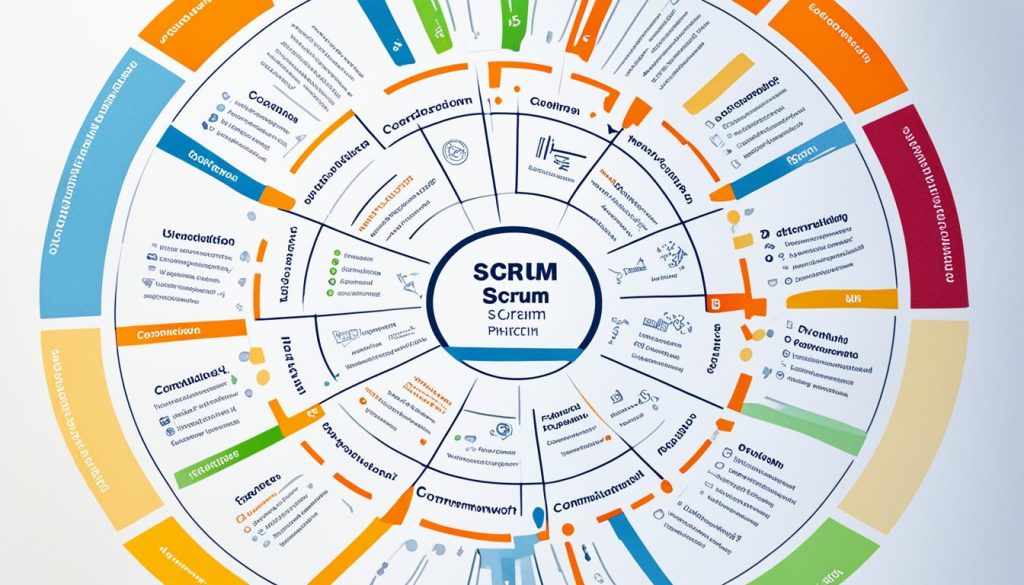- April 30, 2024
- Posted by: Festus Napoleon
- Category: Uncategorized

The Agile Scrum methodology is changing the way companies work. It provides a better, more flexible, and collaborative way to handle projects. At its core, the Scrum framework is key within Agile. It boosts business productivity and helps complete projects faster.
In this article, we dive into how the Scrum framework and Agile Scrum help businesses succeed today. We look at its core principles, the benefits, and how it’s best used. We’ll also share stories to show how Agile Scrum is used in different fields like software, marketing, and manufacturing.
Understanding Scrum and using it in companies helps unlock Agile Scrum’s full potential. This encourages a culture of always learning and getting better. Follow us as we explore how Scrum can really enhance business productivity.
The Agile Revolution
Traditional project management methods often have trouble keeping up with market needs. The Agile Scrum methodology changes how businesses manage projects and make new products. Agile Scrum welcomes change and values flexibility, working together, and keeping customers happy. This makes it a key tool for businesses aiming for success in today’s fast-paced world.
Agile Scrum is different because it knows that what’s important can quickly shift. By using Agile Scrum, businesses can adjust better to these changes, staying ahead in the market. Agile Scrum teams work in quick bursts, or sprints, delivering parts of the project that add value to customers. This way of working lets businesses react fast to customer feedback, improve how they do things, and always get better.
The core of Agile Scrum is the Scrum framework, which is both structured and adaptable. This framework brings team members from different parts of a business together to reach common goals. It has important team roles and specific events, like sprints and reviews, that help keep work on track and everyone working towards the same purpose.
Agile Scrum is changing how companies work together, create new things, and get them to customers. It’s helping businesses keep up with change, stand out in the crowd, and succeed in a competitive world.

Key Benefits of Agile Scrum Methodology:
- Flexibility and adaptability to changes in requirements and priorities
- Faster time-to-market through incremental delivery of value
- Improved customer satisfaction through continuous feedback and collaboration
The Agile Methodology
The Agile methodology values flexibility, teamwork, and customer happiness. It’s more adaptable than the Waterfall method, focusing on adding value step by step. This method allows for constant adjustment and growth.
The traditional Waterfall method moves in a straight line. In contrast, Agile welcomes change and encourages team partnerships. It puts people and their communication first, then the actual working software, customer input, and the ability to change plans.
The Agile Manifesto, crafted by developers in 2001, lays out its core beliefs. It favors personal connections and practical results over strict rules and piles of paperwork. It puts a premium on working closely with customers and being ready to shift directions based on new information.
Applying Agile principles helps organizations build a culture that’s quick to adapt and focused on teamwork. By breaking work into small, achievable steps, progress is steady. This method also makes it easier to steer a project based on feedback, leading to better results for customers.
Getting things done through Agile means facing less risk. By focusing on delivering value regularly, there’s less chance of wasting effort on something people won’t like. This makes big projects feel less overwhelming and more likely to succeed.
In short, the Agile methodology is all about being ready for change and working closely with your team and customers. It stands out from the Waterfall approach by focusing on improving in small steps. This leads to happier customers and successful projects.
The Scrum Framework
The Scrum framework is a popular way to manage projects, part of the Agile approach. It gives companies a method that is both solid and adaptable for project success.
The Scrum method focuses on three main roles: the Product Owner, the Scrum Master, and the Development Team. The Product Owner sets the project’s goals and picks which tasks are most important. The Scrum Master helps the team by removing roadblocks and enhancing teamwork. The Development Team works together to complete the project requirements.
Scrum involves several key events and routines to help teams work well. This includes Sprints, Daily Standups, Reviews, and Retrospectives. During a Sprint, the team focuses on a set of features to complete within a time limit. The Daily Standup is a quick meeting for everyone to update on their progress and plans. The Review lets the team share what they built, gather feedback, and adjust their plan. The Retrospective is a time to review what went well and what could be better for next time.
The Scrum method also uses specific tools to handle the projects. These include the Product Backlog, Sprint Backlog, and Increment. The Product Backlog lists all the tasks, prioritized by importance. The Sprint Backlog includes the tasks chosen for a specific Sprint. The Increment is the work finished at the end of each Sprint.
Scrum highlights the power of teamwork and working together. It promotes a closely-knit team that communicates well and backs each other up. This leads to better ideas, everyone doing their part, and always getting better results.
Using Scrum helps companies work through their projects faster and with more adaptability. It pushes teams to use Scrum’s ideas and methods to improve their project management. This ultimately helps them succeed in their goals.

Benefits of Agile Scrum
Agile Scrum helps teams work better, making a large impact on how well a business does. It’s all about being flexible and able to change quickly, which is key in today’s world. Projects are divided into smaller parts, making it easier to complete and deliver to customers quickly. This fast delivery helps companies to lead their markets and grab new chances. Customer happiness is a top priority, achieved by working closely with them and getting their feedback. This way, the end product really meets their needs and expectations.
Let’s show how the Agile Scrum approach works with a simple story.
Take Company ABC. They were struggling with deadlines and customer needs before Agile Scrum. But after adopting it, they sped up their work by 20%. The method’s flexibility meant they could adjust fast, meeting new customer requests without a hitch. This not only made customers happier but also brought in more business and great reviews from happy clients.

So, in the end, Agile Scrum is a great method for managing complex projects and market changes. It focuses on improving step by step so that businesses can move faster than the rest. Plus, it’s all about keeping customers happy, which is essential for long-term success.
Implementing Agile Scrum
Introducing Agile Scrum to a company needs wise steps and follow-through. Start by teaching your team what Agile and Scrum are. Explain how they help meet business aims.
Setting up a Scrum Team is a big part of this. It includes a Product Owner, Scrum Master, and Developers. These are the key people in making projects successful.
A Product Backlog is vital too. It’s a list of what the product needs, set up in order. This list is how the team knows what to work on first.
Planning sprints is critical. Sprints are short periods for working fast and shipping something on time. This is key in making your work clear and your goals reachable.
Having daily standup meetings is a must. Everyone updates each other and clears any hurdles. This builds a strong team spirit and keeps things moving forward.
Ending each sprint with a review is also important. You show off your work and get feedback. This step keeps your project on track with what the customer wants.
Improvements happen in sprint retrospectives. Everyone looks back, finds what could be better, and makes a plan. This is how your team gets smarter and your projects smoother.

Agile Scrum in Real-Life Business
Agile Scrum isn’t just for making software. It’s used in many different fields to manage projects in a better way. For many tech companies, it has helped in making better products quickly. This means customers get what they want faster.
Marketers are also using Agile Scrum. They find its quick, flexible nature helpful for adapting campaigns to meet changing market needs. Its use in marketing shows how versatile Agile Scrum really is across different areas.
In manufacturing, Agile Scrum is helping businesses work smarter. It focuses on making processes more efficient and reducing waste. This not only improves how they work internally, but also leads to happier customers.
By implementing Agile Scrum, businesses in manufacturing become more agile. They can respond to changes fast and work better as a team. This is a big part of why Agile Scrum is making waves not only in software, but also in marketing and manufacturing.
Overcoming Challenges
The Agile Scrum methodology brings many benefits. But, it can be tough to get everyone on board. Overcoming these difficulties is key to the successful use of Agile in a company.
Resistance to Change
Team members sometimes resist Agile Scrum’s new ways. They may prefer the old approach they know well. To get everyone to try Agile, clear and strong communication is vital. It’s also helpful to show the benefits of Agile and offer training and support.
Incomplete Product Backlog
A messy or unclear product backlog delays progress. This backlog is a list of what needs to be done. It must be clear, up-to-date, and available to the team. Regular updates and discussions with stakeholders keep it on track.
Overcommitting in Sprints
Setting too many goals for a sprint can do more harm than good. This leads to stress and work left undone. Teams should be realistic about what they can accomplish. The Scrum Master helps the team set goals that are challenging but not overwhelming.
Education and training should be top priorities for Agile teams. This lays a strong foundation for Agile practices. Also, good communication and collaboration are key. They ensure everyone is moving in the same direction. Addressing these challenges directly can greatly improve project outcomes.
The Future of Agile Scrum
The future of Agile Scrum is bright in today’s dynamic business world. Companies see the benefit of using Agile methods to keep up and address market changes. For firms to thrive, they must always learn and get better.
Agile Scrum will keep getting better to meet upcoming business needs. It will mix in new methods, ways, and tools to boost how fast and well work gets done. By following the latest trends and methods, companies stay agile at the front of the pack.
Learning all the time is key to Agile Scrum’s success. Firms should give their teams training to up their know-how and skills. This way, teams can take full advantage of Agile Scrum, making work more productive.
Adapting to Changing Needs
Agile Scrum fits right in when market and customer needs shift. It helps companies react fast and bring value. Agile Scrum’s step-by-step approach turns big tasks into smaller, easier parts. This lets teams move quicker and improve as they work.
By using Agile Scrum’s ideas, companies get better at what they do. This means always learning and making things better. Agile Scrum boosts talking, working together, and looking back on what’s been done. It helps spot where things can be better and make changes right then.
Investing in Training and Development
Training and growing skills are key for Agile Scrum’s future success. Giving team members the know-how they need boosts Agile skills. It keeps the company improving all the time. Training can teach about Agile, Scrum, and technical skills.
It’s also good for teams to go to events and workshops to keep in touch with Agile trends. Meeting experts and peers can offer great tips and help Agile Scrum grow.
Developing a culture of constant learning and bettering is vital. By embracing Agile Scrum’s future, firms can navigate market changes, wow customers, and succeed.
Scrum Master: Unlocking the Power of Scrum
In the Scrum framework, the Scrum Master ensures the team follows its rules. They lead events like Sprint Planning and the Daily Standup. Their job is to guide the team, remove problems, and help everyone work together.
The Scrum Master is a servant-leader who helps the team and product owner. They make sure the team knows how to use Scrum right. They improve the team’s way of working and make sure everyone does their part.
The Scrum Master supports the Scrum process and builds teamwork. They boost open talks and clear sharing of information. They help the team make decisions well and stick to Scrum rules like timeboxing and using Scrum tools.
Taking on the Scrum Master role means protecting the Scrum way. They steer the team to work better and finish projects well. With their skill and leading, the Scrum Master makes Scrum work best for business.
Conclusion
Investing in Scrum training is vital for any organization looking to succeed. It involves not just learning new things, but also changing how we think. Scrum teaches us to work together, be creative, and be ready for anything.
By working as a team and understanding everyone’s role, developers can become experts in using Scrum. This helps them lead projects to success.
Aside from training, using certain technical methods can also improve how we work. These methods help teams make better products, avoid mistakes, and beat rivals. Techniques like test-driven development and automated testing make it possible to create top-notch products quickly.
When you combine both the training and these technical methods, something powerful happens. It opens the door to all Scrum can offer. With the best training and tools, businesses can make a place where getting better and being innovative is normal. This leads to more work getting done and growth that can keep up with the world today.

